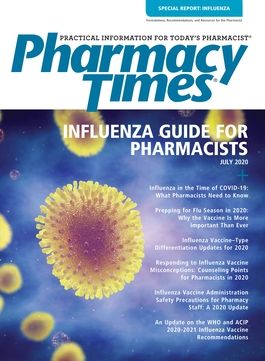Publication
Article
Supplements
An Update on the WHO and ACIP 2020-2021 Influenza Vaccine Recommendations
Author(s):
To combat influenza, widespread vaccination efforts by health care providers must be combined with a targeted and effective annual influenza vaccine.
According to the CDC, between 39 million and 56 million cases of influenza occurred in the United States during the 2019-2020 influenza season, leading to 26 million medical visits, 740,000 hospitalizations, and 62,000 deaths.1 To combat this deadly disease, widespread vaccination efforts by health care providers must be combined with a targeted and effective annual influenza vaccine. The specific viruses used to create the annual vaccine are different each year and are selected from among those expected to be the most problematic during the upcoming influenza season.
The World Health Organization (WHO) provides guidance on the development and production of influenza vaccines to national regulatory bodies and vaccine manufacturers in each country. WHO recommends separate vaccine components for the northern and southern hemispheres.2 These recommendations are based on reports from the Global Influenza Surveillance and Response System(GISRS), which monitors influenza virus activity worldwide.3 Because circulating influenza viruses continually evolve, constant surveillance is a key component of creating an effectivevaccine. Criteria used by the GISRS to determine candidate vaccine virus (CVV) recommendations are displayed in table 1.3

2020-2021 INFLUENZA VACCINES
In February 2020, the WHO released recommendations for the composition of the influenza virus vaccine in the northern hemisphere for use during the 2020-2021 influenza season.2 Influenza virus names are based on virus type (influenza A or B), geographic origin, strain number, year of collection, and virus subtype or lineage (eg, H3N2 or B/Victoria lineage).4 The 2020-2021 recommendations from the WHO for quadrivalent and trivalent influenza virus vaccines are displayed in table 2.2

In the United States, the Advisory Committee on Immunization Practices (ACIP), a committee within the CDC, uses the WHO vaccine recommendations.5 The ACIP has 15 voting members who are US medical and public health experts. On June 24, 2020, the committee met to discuss influenza vaccines, meningococcal vaccines, and coronavirus disease 2019 (COVID-19) vaccine development.6 During the meeting, the members voted on and approved the WHO recommendations for the annual influenza vaccination components. Because vaccine production is a 6- to 8-month-long process after the viruses have been chosen, ACIP’s recommendations are a time-sensitive component of vaccine production in the United States.
Additionally, the advisory committee voted to recommend an annual influenza vaccine for all individuals over the age of 6 months and the use of 2 new vaccines for older adults during the upcoming influenza season.6 Fluzone high-dose trivalent will be replaced by Fluzone high-dose quadrivalent, and the Fluad high-dose quadrivalent vaccine will also be available for use in this population.
CONCLUSIONS
Producing a targeted and effective vaccine is critical in reducing cases of influenza globally, particularly as the world faces new health threats such as COVID-19. As frontline health care providers, pharmacists can aid in building public awareness of the importance of receiving an annual influenza vaccine and provide education on the latest vaccines by keeping up to date on the latest approvals and recommendations.
Kimberly C. McKeirnan, PharmD, BCACP, is a clinical assistant professor in the department of pharmacotherapy at the Washington State University College of Pharmacy and Pharmaceutical Sciences in Spokane, Washington.
REFERENCES
- 2019-2020 U.S. flu season: preliminary burden estimates. CDC. Updated April 17, 2020. Accessed July 1, 2020. https://www.cdc.gov/flu/about/burden/preliminary-in-season-estimates.htm
- Recommended composition of influenza virus vaccines for use in the 2020-2021 northern hemisphere influenza season. WHO. February 28, 2020. Accessed July 1, 2020. https://www.who.int/influenza/vaccines/virus/recommendations/2020-21_north/en/
- Global Influenza Surveillance and Response System (GISRS). WHO. Accessed July 1, 2020. https://www.who.int/influenza/gisrs_laboratory/en/
- Types of influenza viruses. CDC. Updated November 18, 2019. Accessed July 1, 2020. https://www.cdc.gov/flu/about/viruses/types.htm
- Advisory Committee on Immunization Practices (ACIP). CDC. Updated March 24, 2020. Accessed July 1, 2020. https://www.cdc.gov/vaccines/acip/index.html
- ACIP meeting information. CDC. Accessed July 1, 2020. https://www.cdc.gov/vaccines/acip/meetings/index.html







